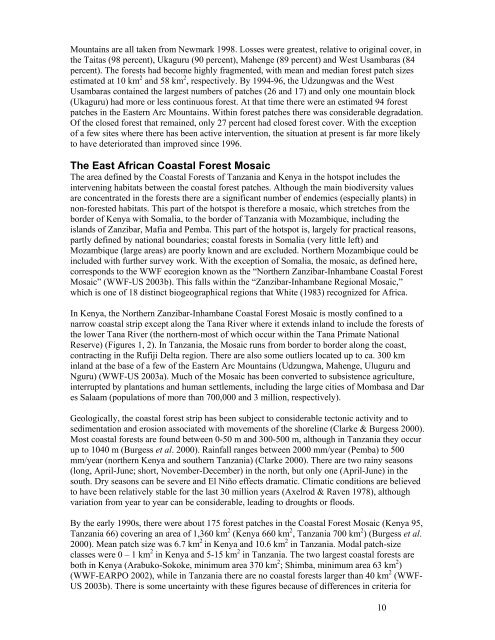Eastern Arc Mountains and Coastal Forests of Tanzania and Kenya ...
Eastern Arc Mountains and Coastal Forests of Tanzania and Kenya ...
Eastern Arc Mountains and Coastal Forests of Tanzania and Kenya ...
You also want an ePaper? Increase the reach of your titles
YUMPU automatically turns print PDFs into web optimized ePapers that Google loves.
<strong>Mountains</strong> are all taken from Newmark 1998. Losses were greatest, relative to original cover, inthe Taitas (98 percent), Ukaguru (90 percent), Mahenge (89 percent) <strong>and</strong> West Usambaras (84percent). The forests had become highly fragmented, with mean <strong>and</strong> median forest patch sizesestimated at 10 km 2 <strong>and</strong> 58 km 2 , respectively. By 1994-96, the Udzungwas <strong>and</strong> the WestUsambaras contained the largest numbers <strong>of</strong> patches (26 <strong>and</strong> 17) <strong>and</strong> only one mountain block(Ukaguru) had more or less continuous forest. At that time there were an estimated 94 forestpatches in the <strong>Eastern</strong> <strong>Arc</strong> <strong>Mountains</strong>. Within forest patches there was considerable degradation.Of the closed forest that remained, only 27 percent had closed forest cover. With the exception<strong>of</strong> a few sites where there has been active intervention, the situation at present is far more likelyto have deteriorated than improved since 1996.The East African <strong>Coastal</strong> Forest MosaicThe area defined by the <strong>Coastal</strong> <strong>Forests</strong> <strong>of</strong> <strong>Tanzania</strong> <strong>and</strong> <strong>Kenya</strong> in the hotspot includes theintervening habitats between the coastal forest patches. Although the main biodiversity valuesare concentrated in the forests there are a significant number <strong>of</strong> endemics (especially plants) innon-forested habitats. This part <strong>of</strong> the hotspot is therefore a mosaic, which stretches from theborder <strong>of</strong> <strong>Kenya</strong> with Somalia, to the border <strong>of</strong> <strong>Tanzania</strong> with Mozambique, including theisl<strong>and</strong>s <strong>of</strong> Zanzibar, Mafia <strong>and</strong> Pemba. This part <strong>of</strong> the hotspot is, largely for practical reasons,partly defined by national boundaries; coastal forests in Somalia (very little left) <strong>and</strong>Mozambique (large areas) are poorly known <strong>and</strong> are excluded. Northern Mozambique could beincluded with further survey work. With the exception <strong>of</strong> Somalia, the mosaic, as defined here,corresponds to the WWF ecoregion known as the “Northern Zanzibar-Inhambane <strong>Coastal</strong> ForestMosaic” (WWF-US 2003b). This falls within the “Zanzibar-Inhambane Regional Mosaic,”which is one <strong>of</strong> 18 distinct biogeographical regions that White (1983) recognized for Africa.In <strong>Kenya</strong>, the Northern Zanzibar-Inhambane <strong>Coastal</strong> Forest Mosaic is mostly confined to anarrow coastal strip except along the Tana River where it extends inl<strong>and</strong> to include the forests <strong>of</strong>the lower Tana River (the northern-most <strong>of</strong> which occur within the Tana Primate NationalReserve) (Figures 1, 2). In <strong>Tanzania</strong>, the Mosaic runs from border to border along the coast,contracting in the Rufiji Delta region. There are also some outliers located up to ca. 300 kminl<strong>and</strong> at the base <strong>of</strong> a few <strong>of</strong> the <strong>Eastern</strong> <strong>Arc</strong> <strong>Mountains</strong> (Udzungwa, Mahenge, Uluguru <strong>and</strong>Nguru) (WWF-US 2003a). Much <strong>of</strong> the Mosaic has been converted to subsistence agriculture,interrupted by plantations <strong>and</strong> human settlements, including the large cities <strong>of</strong> Mombasa <strong>and</strong> Dares Salaam (populations <strong>of</strong> more than 700,000 <strong>and</strong> 3 million, respectively).Geologically, the coastal forest strip has been subject to considerable tectonic activity <strong>and</strong> tosedimentation <strong>and</strong> erosion associated with movements <strong>of</strong> the shoreline (Clarke & Burgess 2000).Most coastal forests are found between 0-50 m <strong>and</strong> 300-500 m, although in <strong>Tanzania</strong> they occurup to 1040 m (Burgess et al. 2000). Rainfall ranges between 2000 mm/year (Pemba) to 500mm/year (northern <strong>Kenya</strong> <strong>and</strong> southern <strong>Tanzania</strong>) (Clarke 2000). There are two rainy seasons(long, April-June; short, November-December) in the north, but only one (April-June) in thesouth. Dry seasons can be severe <strong>and</strong> El Niño effects dramatic. Climatic conditions are believedto have been relatively stable for the last 30 million years (Axelrod & Raven 1978), althoughvariation from year to year can be considerable, leading to droughts or floods.By the early 1990s, there were about 175 forest patches in the <strong>Coastal</strong> Forest Mosaic (<strong>Kenya</strong> 95,<strong>Tanzania</strong> 66) covering an area <strong>of</strong> 1,360 km 2 (<strong>Kenya</strong> 660 km 2 , <strong>Tanzania</strong> 700 km 2 ) (Burgess et al.2000). Mean patch size was 6.7 km 2 in <strong>Kenya</strong> <strong>and</strong> 10.6 km 2 in <strong>Tanzania</strong>. Modal patch-sizeclasses were 0 – 1 km 2 in <strong>Kenya</strong> <strong>and</strong> 5-15 km 2 in <strong>Tanzania</strong>. The two largest coastal forests areboth in <strong>Kenya</strong> (Arabuko-Sokoke, minimum area 370 km 2 ; Shimba, minimum area 63 km 2 )(WWF-EARPO 2002), while in <strong>Tanzania</strong> there are no coastal forests larger than 40 km 2 (WWF-US 2003b). There is some uncertainty with these figures because <strong>of</strong> differences in criteria for10
















